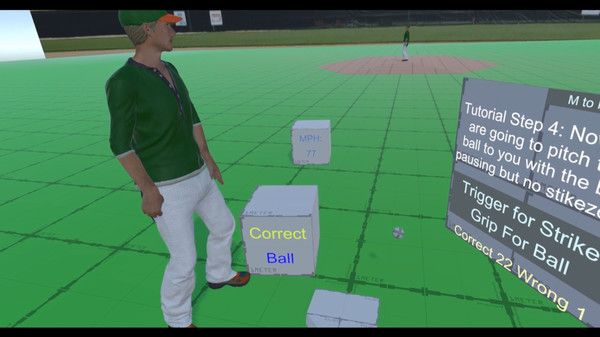This review was originally created in July 2018 for HTC, targeted to their Vive/Vive Pro (VIVEPORT). It is reproduced here without alteration.
Umpires have been part of baseball since the creation of the modern game in the 1840s. Whether you like the job a particular umpire does or not, it’s undeniable that the role is indispensable for the sport of baseball.
While all within the umpiring crew play an important role in policing the sport’s rules, none are as critical as the head, or plate, umpire. Of course, among the head umpire’s range of duties, the highest profile is calling balls and strikes from behind the plate. Umpire Simulator makes you a head umpire and challenges you to correctly identify whether fastballs and breaking balls, including curve balls and sliders, are balls or strikes.
The setup is simple. After a series of tutorials where you’re shown what a range of balls and strikes looks like, you’re then challenged to correctly determine what’s thrown on your own, with pitches ranging from 75 mph to 105 mph. Every correct guess is tallied under Correct and every incorrect guess is tallied under Wrong. Get enough Wrong and the simulation ends.
Umpire Simulator can be played seated or standing in a room-scale environment of any size. Either Vive controller can be used to indicate a ball (Grip button) or strike (Trigger button).
Originally developed several years back as a standard software simulation, the more recent jump to virtual reality allows for you to position yourself from just about any angle or location behind the plate to more easily see a ball’s flight path. The greater immersion that virtual reality allows for also gives a nice sense of the ball’s speed and an appreciation for how fast some pitches can be thrown in real life.

From an audio-visual standpoint, Umpire Simulator‘s presentation is crude. Instead of modeling a baseball stadium or park, the developer has chosen static background panels that don’t blend together in any discernible way. There’s also no field or turf, just a metered grid that the two virtual players, a pitcher and batter, stand on. The pitcher and batter themselves are also poorly rendered. In fact, the batter model just stands there, arms at his side. There’s no attempt to show the batter with an actual bat in his hands or with any signs of life whatsoever. Finally, audio is limited to the ball hitting the unseen virtual catcher’s mitt.
The sub-par presentation could perhaps be excused if there was a lot of depth to the simulation, but it really is just about you calling balls and strikes correctly. There’s literally nothing else to it. If you really want to know what it’s like to be a head umpire, and to specifically see what it’s like to call balls and strikes, Umpire Simulator offers that. For me, however, by the time I finished the tutorial and was in the middle of calling a few dozen balls and strikes on my own, I was already hoping the simulation would be over.
As a practice tool for active or would-be umpires, I can see Umpire Simulator having some value, particularly since there’s nothing else quite like it out there. For everyone else, however, particularly given the lack of care to the presentation, there’s really nothing here to hold our attention.
Score: 2 out of 5 stars.
Umpire Simulator is available on Viveport or with a Viveport Subscription.






 Your total news and information resource for all things Science, Technology, Engineering / Mathematics, Art, and Medicine / Health.
Your total news and information resource for all things Science, Technology, Engineering / Mathematics, Art, and Medicine / Health.
Leave a Comment